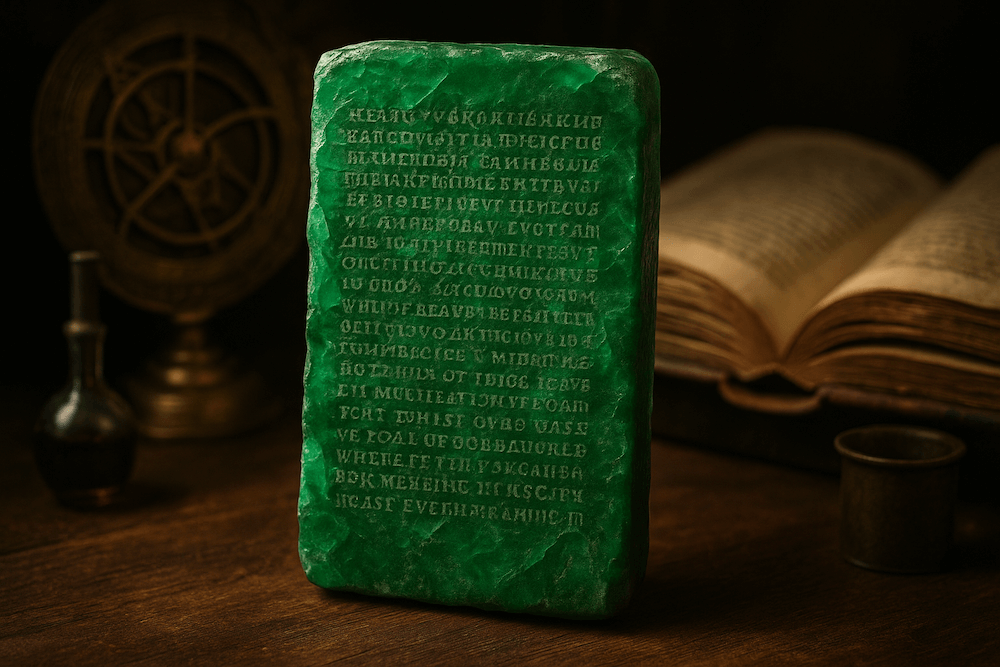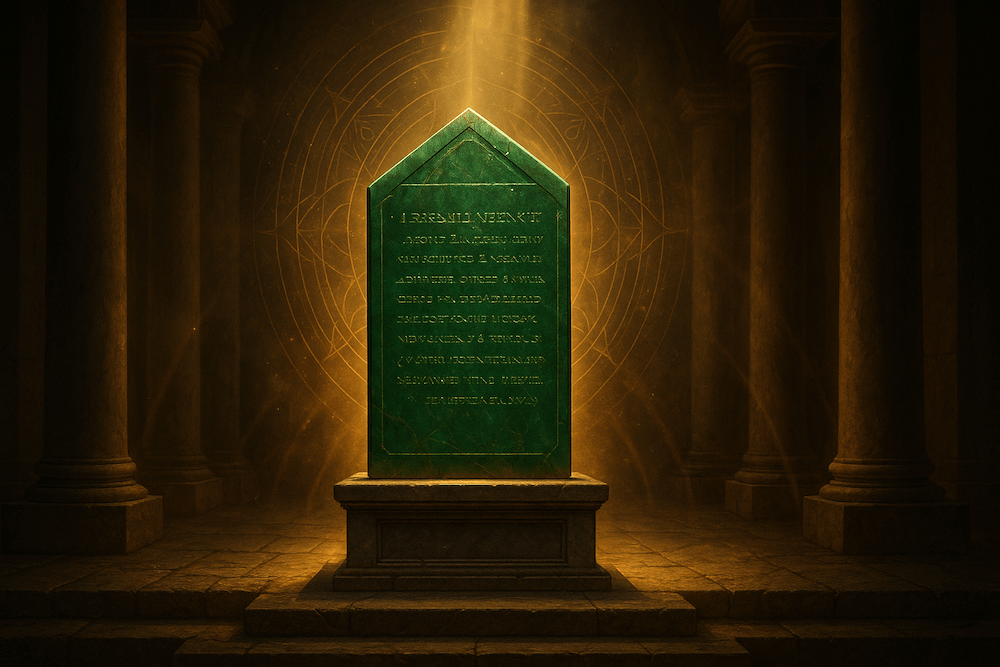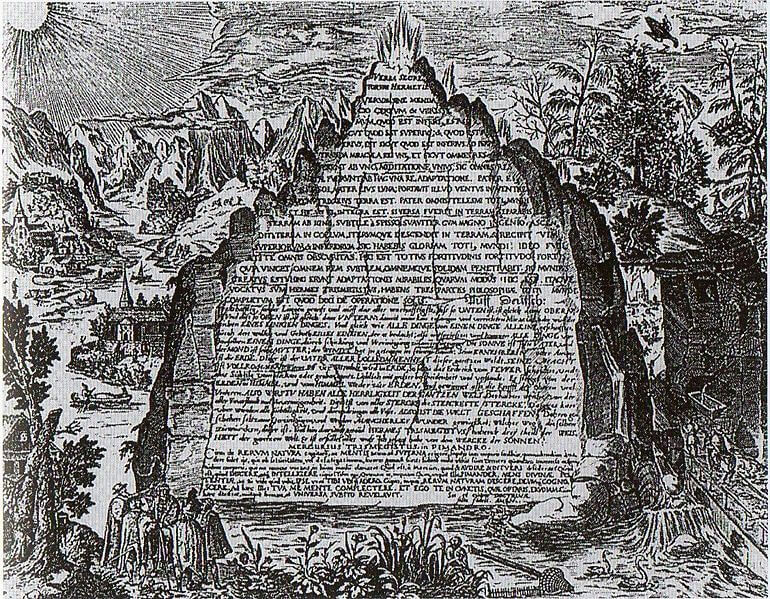The Emerald Tablet is one of the most revered and mysterious objects in the history of esoteric knowledge. This short, mysterious text is said to have been written by the famous Hermes Trismegistus. It is thought to be the first book on alchemy and Hermetic philosophy. For hundreds of years, alchemists, magicians, and philosophers have been fascinated by its mysterious lines, which promise to hold the key to understanding the nature of reality. But what is this old tablet? Does it have the knowledge to turn lead into gold, or does its wisdom point to a deeper, spiritual change? Come with us as we explore the Emerald Tablet's history, legends, theories, and lasting power.

What is the Emerald Tablet? It is the source of all wisdom.
The Emerald Tablet, or Tabula Smaragdina in Latin, is a short, mysterious text that talks about the rules of creation and how everything is connected. The most famous saying from it is "That which is Below corresponds to that which is Above, and that which is Above corresponds to that which is Below, to accomplish the miracle of the One Thing."
The phrase "As Above, so Below" is the most important part of Western esotericism. It suggests a universe in which the microcosm (the individual, the Earth) mirrors the macrocosm (the cosmos, the divine). To comprehend one is to comprehend the other.
The short text is a thick allegorical guide. Here is a well-known translation from Latin:
True, without a doubt, certain, and most true.
What is below is the same as what is above, and what is above is the same as what is below, because the One Thing does miracles.
And just as everything came from One, through One, so everything has its birth from this One Thing by adaptation. The Sun is its father, and the Moon is its mother.
The Wind carried it in its belly, and the Earth is its nurse. The father of all perfection in the whole world is here.
If it is turned into earth, its force or power is complete.
With great care and sweetness, separate the earth from the fire, the subtle from the gross.
It rises from the earth to the sky and then back down to the earth, where it gets the power of things above and below it.
In this way, you will have the glory of the whole world, and all darkness will leave you.
Its power is greater than all other powers because it can defeat anything that is subtle and go through anything that is solid.
So was the world made.
From this, good adaptations do come, and the means (or process) is here in this.
That's why I'm called Hermes Trismegistus, because I have the three parts of the philosophy of the whole world.
What I said about how the Sun works has been done and is over.

The Hard-to-Find Origins: History and Myth
There are many stories about where the Emerald Tablet came from. People think that Hermes Trismegistus wrote the text. He is a mix of the Greek god Hermes (the messenger of the gods) and the Egyptian god Thoth (the god of wisdom, writing, and magic). People in the Hellenistic period thought of this "Thrice-Great" Hermes as a wise pagan prophet who knew the secrets of the universe.
Legend says that the tablet is thousands of years old, maybe from the time of Atlantis. However, historians agree that the earliest known mention of it is in an Arabic text called Kitab Sirr al-Khaliqa (Book of the Secret of Creation), which dates back to the 6th to 8th centuries CE. This work tells the story of how it was found. The story says that a person named Balinas (a fake Apollonius of Tyana) found a secret room under a statue of Hermes. He saw an old man sitting on a golden throne inside, holding the green tablet.
In the 12th century, the text was translated into Latin, which made it known to European alchemists. It became a key part of their art, and famous people like Isaac Newton, who was both a scientist and an alchemist, made their own translations.
Figuring Out the Text: Theories and Meanings
The Alchemical Interpretation:
The tablet was a guide for real alchemists who wanted to make the Philosopher's Stone, a mythical substance that could turn base metals into gold and give people eternal life. People thought that the text's mentions of the "Sun" (gold), "Moon" (silver), and the separation of elements ("earth from the fire, the subtle from the gross") were secret instructions for the Great Work (Magnum Opus). People thought that the process of going up from earth to heaven and then back down again was like the process of distillation and condensation in an alchemical lab, which eventually made a substance that combined the powers of heaven and earth.
The Spiritual Meaning:
For spiritual and esoteric thinkers, the alchemical language is only a metaphor. The change of "base metals" into "gold" is a metaphor for how an impure soul can become spiritually enlightened and perfect. The laboratory is the self, and the chemical processes are steps in meditation, spiritual discipline, and inner purification. The phrase "As Above, so Below" means that we can understand the divine by looking at the universe and ourselves by looking at our own inner world.

Myths, Conspiracies, and Legends
The Link to Atlantis:
A well-known story from the 20th century says that Hermes Trismegistus was an Atlantean priest-king named Thoth. In this story, Thoth wrote the tablet to keep the knowledge of the doomed civilization of Atlantis safe. He hid it in the Great Pyramid of Giza so that a worthy successor could find it. This theory says that the tablet's wisdom is much older than what we know from history.
Secret Societies:
Many secret societies, from the Rosicrucians of the 17th century to different occult orders today, have made the Hermetic wisdom of the tablet a central theme. These groups think that the tablet has secret knowledge that has been passed down through a long line of initiates and that only those who are ready to understand it can do so.
The Other Emerald Tablets:
Maurice Doreal, an American occultist, added to the story of the single tablet in the 20th century. He wrote a book called The Emerald Tablets of Thoth the Atlantean in which he said he translated twelve emerald tablets he found in a secret room in the Great Pyramid with the help of the "Pyramid Priesthood." This version of the story has much more complex stories about a hollow Earth, advanced ancient technology, flying saucers, and fights with reptilian aliens. Historians think that Doreal's claims are modern fiction and have nothing to do with the historical Tabula Smaragdina.
The Tablet's Lasting Legacy
The Emerald Tablet has had an undeniable impact, whether people see it as a historical object, a spiritual guide, or a mythical key to great power. Its main idea, "As Above, so Below," has had a big impact on Western thought, shaping everything from Renaissance art and Jungian psychology to modern New Age spirituality.
The Emerald Tablet's true power may not be in the green stone object itself, but in the philosophical puzzle it poses that will last forever. It makes us think of the world as a single, interconnected whole, where the stars above and the soul within all move to the same cosmic beat. The search for meaning in its strange lines is really a search for meaning in ourselves and our place in the universe.
